COVER- First and long: As football kicks off, emotions run high at Virginia Tech

PHOTO BY TOM DALY
Normally, college students are not well acquainted with the hour of 7:30am. But this is not just any 7:30am. It's Saturday, September 1, the morning of the first Virginia Tech football game of 2007. ESPN has chosen the Blacksburg campus as the site for College GameDay, the network's weekly college football preview show. So hundreds of Hokies are up unusually early, lined up at the soccer field adjacent to Lane Stadium. They stand behind a chain link fence, peering in at the set they've seen on TV, waiting for a prime spot in front of the cameras.
At a glance, regular viewers would recognize the crowd as the typical GameDay backdrop: rowdy undergrads dressed (some of them painted) in school colors, shouting traditional school cheers, and carrying all manner of handmade signs. However, a closer look reveals that the majority of the signs are far from typical– they're thank-you cards to all of the schools who lent their support to the Hokies at their darkest hour.
"Thank you Syracuse!"
"Thank You Penn State"
"Thank you ODU"
"Because of you... we will prevail"
The homemade placards are just one reminder of why this Saturday in Blacksburg is unlike any other in the history of this university or even this sport. At this hour 138 days earlier, a disturbed young man had just shot and killed two of his fellow students, and would go on to take the lives of 29 others before taking his own life– the deadliest single incident of gun violence in American history.
At 8am the gates open, and the Tech faithful become a blur, rushing past the yellow-jacketed security guards to cover the green artificial turf in a flood of maroon and orange. A hearty few had camped out since 4:30 the previous afternoon, but Hokies everywhere have been waiting much longer for this moment. Though Hokie Nation has had other opportunities to gather since April 16, this is the first chance they've had to take this giant step toward normal, by showcasing what had been their previous claim to fame: one of the most vocal cheering sections in college football.
Kickoff isn't for another four hours, but in some ways Virginia Tech has already won.
These days, the grounds of Virginia Tech do not look like a place hallowed by tragedy. On a quick Friday afternoon tour before the big game, the signs of ordinary college life are everywhere: classroom auditoriums filled to the top row; students chatting on cell phones about weekend plans; groaning cadets enduring their drill instructors' not-so-subtle critiques during a marching exercise; empty cans of Natural Light tossed beside academic buildings (each complete with a "shotgun" hole in the side for quick consumption). Even by West Ambler Johnston, the dormitory where the first murderous shots rang out, students celebrate the sunny weather with a game of pickup volleyball.
This upbeat attitude is not just a brave front in the face of adversity. It's a direct response to university president Charles Steger's April 17 convocation address that asked students "to slowly and painfully, but inevitably, begin to heal and to again move forward."
"This campus was close already, but this has united everyone in a different way," says junior Jordan Endahl of Charlottesville. "I've noticed that now, nobody lets a door slam on anybody. No matter where you go, people hold doors for each other, and people say thank you."
Everywhere in Blacksburg are reminders of the horror that visited four-and-a-half months ago. Students wear maroon shirts emblazoned "Hokies United." Just across Main Street, Blacksburg Baptist Church flies a row of American flags occasionally broken by standards from India, Puerto Rico, and Egypt– a reminder of the diversity of the 32 victims.
The university has constructed an official memorial, prominently located on the north side of Tech's central green– known as the Drillfield– in front of Burruss Hall, the school's iconic administration building. The memorial is a simple two-tiered design. A first-level walkway leads visitors past 32 stones set in a semicircular rock garden, each engraved with a name. The walkway leads upward to the second level, where visitors find a single rectangular stone laid in the ground, bearing the refrain made famous by English professor Nikki Giovanni in her April 17 Convocation remarks: "We will prevail. We are Virginia Tech."
This weekend is the first time many alumni have returned to their alma mater since the tragedy. Though news coverage had burned into their consciousness images of bloodshed jarringly juxtaposed with familiar gray buildings, walking through the memorial makes the television images seem real.
"I walked this Drillfield so many times as a student," says Erin Stacy, a 2002 graduate who now lives in Richmond. "It's unbelievable that they would have to have a memorial here for this purpose. But here it is, and every stone has a name."
While thousands pass through the memorial over the course of the weekend, only a handful of them walk the few steps north to Norris Hall, where 30 students and faculty lived a nightmare and never woke up.
The area surrounding Norris retains the last remnant of the numbed silence that engulfed the entire campus in the immediate aftermath. Hardly anyone walks by, and nobody speaks above a whisper. After the building was closed following the massacre, officials began a phased reopening in June that will convert all the classrooms to offices and labs.
Yellow signs on the doors warn, "Valid Virginia Tech ID is required for entry." Sheets of plastic billow from an open window. A lone orange flower adorns the "Norris Hall" sign. Of all the scenes in Blacksburg, this is the one that most renders the previously unimaginable palpable.
"The memorial is the memory," says Matthew Ballengee, "but this is where the lives were lost." A 1998 East Carolina graduate, Ballengee is in town for the game. But like many, he felt drawn to the site of the catastrophe. "To stand in this spot," he says, "is a weird, emotional feeling."
Bob Hall, a member of the Virginia Tech class of 1969 (the same class as Steger and head football coach Frank Beamer), drove up from Kitty Hawk, North Carolina. He and his wife, Betty, had to see Norris for themselves.
"You don't want to be leering, but we were here, so we walked over," he says. "It makes your heart hurt."
That hurt is an all-too-familiar feeling for students who witnessed the massacre. Despite Tech's population of 26,000 undergraduates, many students have a personal connection to the tragedy.
Senior Ryan Yanulites of Tallahassee, Florida spent that afternoon scrambling to account for fellow members of Pi Kappa Alpha.
"Three guys had class in Norris, and two of them didn't go," he says, "but one of them was in the class with the Romanian professor."
After finally tracking down his friend and finding him safe, Yanulites heard a startling account of how engineering professor and Holocaust survivor Liviu Librescu had truly been his brother's keeper.
"While [Librescu] was holding the door," says Yanulites, "my friend was one of the last people to get out. He said he could see him being shot as he was jumping out the window."
According to Yanulites, that memory is not often discussed.
"He doesn't really talk about it," he says of his fraternity brother. "We've always said we're here for him when he wants to."
Park Loyd, a junior from Lexington, Kentucky, knew something wasn't right when he returned to the Terrace View Apartments to find his upstairs neighbors in the parking lot crying, one of their roommates missing.
"I knew something had happened to Jarrett," he says.
Senior Jarrett Lane was one of nine students killed in G.V. Loganathan's Advanced Hydrology class in Norris 206. Though Loyd didn't know Lane well, he says he could hardly have asked for a better neighbor.
"Jarrett was a classy, outgoing, good-natured, good ol' boy," says Loyd. "He wanted to meet everybody, so he'd have people over. These were not college parties the way you normally think of them. They were always very chill, not in-your-face, relaxed. Kind of like he was."
One of the things Loyd remembers most about that spring was the fact that even though Lane was gone, his presence was still apparent.
"His Honda Civic was parked right in front of my window," he recalls. "I went home that weekend, and when I came back it was still there. I think it took about a week for them to take it away."
What's more, Loyd had noticed Lane's roommates' cars had also stayed put since that horrible Monday. So he reached out to them in the same spirit Lane demonstrated when he knocked on Loyd's door as a complete stranger at the beginning of the year.
"My mom lost her mom when she was in college, and she told me it was worst when people just didn't say anything because they didn't know what to say," he says. "So I left a note on one of their cars just saying that my roommates and I were sorry for their loss and to come talk if they felt like it."
Eventually, one of Jarrett's friends came downstairs to take Loyd up on his offer.
"It was awkward because we're all guys, and I don't think he wanted to show weakness," he says. "I remember he thanked us for the note, but we didn't talk much."
Junior Elizabeth Reeves, from the small Shenandoah Valley town of Broadway, lived the events of April 16 up close in more ways than one. She was walking to class in Dalton Brown Hall– just two buildings away from Norris– when she heard the now infamous "popping" noises from the guns of Cho Seung-Hui.
"They didn't register to me as gunshots," she says.
By the time she got to class, the campus was in lockdown, and Reeves sat in the classroom experiencing the surreal moment shared by so many Tech students: watching on television the events happening just outside the door and frantically phoning friends and family.
"I couldn't get hold of my parents or anyone else on my cell phone," she says. "You couldn't figure out who was safe and who wasn't."
Two-and-a-half hours later, Reeves returned to her dorm, still unable to account for one of her close friends. Soon, she learned the unthinkable: 19-year-old sophomore Caitlin Hammeren was among the 11 students who died in Jocelyn Couture-Nowak's Intermediate French class in Norris 211.
"We were talking about living together this year," says Reeves. "There's not a day that goes by when I don't think about what that would have been like."
Hammeren was also Reeves' resident advisor, a role she says her friend was born for.
"I would go into her room just to say hi, and we'd end up talking for 20 minutes about our lives," Reeves recalls. "Our classes– we took all our classes together– our problems, our lives, everything. She always took the time to listen to people."
Though Reeves was close to Hammeren, she says her friend shared that same warmth with just about everyone.
"Before Christmas break she made each of her residents– and there were about 60 of them– personalized Christmas cards," she recalls. "It was little things like this that made her such a unique and caring person."
Try as Reeves did to resume her everyday life as a student, the signs of Hammeren's life awaited her every time she returned to her dorm room.
"It was weird walking past her door everyday," she says, "but it reminded me that she's always watching over us."
So, instead of trying to wash away the anguish of losing a loved one, Reeves holds on to the remnants of her friend's life.
"I still can't delete her number from my phone," she says. "I can't erase her."
Raw as these feelings remain, one emotion that appears to be lacking around Blacksburg is anger, at least regarding placing blame. Friday is the day after Governor Tim Kaine's appointed Virginia Tech Review Panel issued its final report on ways the massacre could have been prevented, and media the world over have been abuzz about the panel's blunt call for reform– particularly regarding the university's mental health system and the killer's history of mental instability.
"The system failed for lack of resources, incorrect interpretation of privacy laws, and passivity," the report alleges. "No one knew all the information, and no one connected the dots."
Investigating how the killer illegally purchased his two guns when his mental illness should have turned up in a federal database, the panel said, "Virginia did not require that persons such as Cho– who had been ordered into out-patient treatment but not committed to an institution– be reported to the database."
And in their probe of why it took more than two hours to inform the campus about the two killings in West Ambler Johnston, the panel blasted Virginia Tech police for not acting sooner to request a campus-wide notification.
Following the panel's press conference, Steger held one of his own in which he flatly disagreed with the report, stating, "I believe, based on what we knew at the time, that we did the right thing, quite honestly."
Despite calls for Steger's resignation by the family of one murdered student, his sentiment resonates with many students.
"Nobody could have seen this coming," says Endahl. "Knowing what we know now, if you put yourself in Steger's shoes, I don't think anything more could have been done."
"It's easy to be critical when you're 1000 miles away," says fellow Charlottesvillian and junior Matt Durkin. "But when we got that e-mail, we knew something wasn't right. The people who are critical weren't here."
Even Steger's actions to commemorate the lost lives have come under scrutiny. On August 1, the president announced that a "Concert for Virginia Tech" would take place in Lane Stadium on Thursday, September 6, featuring Dave Matthews Band. Further down the bill was New York rapper Nas, whose history of lyrics about gun violence and murder raised more than a few eyebrows.
"Dr. Steger has to go," said Bill O'Reilly in a segment on his Fox News program, The O'Reilly Factor. "If one of my children had been killed at VT, I could not forgive Steger for this latest abomination." O'Reilly posted Steger's email address and phone number on the show's website and encouraged viewers to call and write Steger's office.
Tech's student newspaper, the Collegiate Times, also weighed in. Their editorial board wrote on August 9, "Songs that glorify murder do not belong at a concert for the friends and families of murder victims."
But some students stand by Steger.
"A lot of Nas' songs would be inappropriate," says Yanulites. "But a lot of them aren't, and I think as long as he sticks to those, I don't have a problem with him being there."
Not only are students standing behind their college president and administration, some even refuse to criticize one of the aftermath's most popular targets: the news media– NBC News in particular– for airing portions of the photographs and videos the killer sent to NBC's New York office during the lull between the shootings. Many have said the videos might glorify him to other deranged individuals. On the contrary, these students say, the unsettling images of the killer posing with guns and ranting into the camera helped make sense of an otherwise senseless act.
"It gave me an idea of how disturbed he was," says Durkin. "When I saw just the yearbook picture, I thought, 'This campus is such a happy place, and this looks like it could have been anyone.' But when I saw the tapes, it helped me to understand how screwed up he was and why he did what he did."
"If he had been an average student, it would have made it way more scary," agrees Endahl. "You can't blame NBC for what they did– any of the other news channels would have done the same thing– but it was good to see how crazy he was."
Unfortunately for Virginia Tech, the bad news did not end in the spring.
As the university began its first academic year since the tragedy, the community's morale has taken several more hits. On August 20, the day before classes began, 23 people– including 19 students– living in the Collegiate Suites apartment complex were overcome by carbon monoxide poisoning from a faulty gas water-heater valve. Four 19-year-old women were hospitalized in critical condition. Though all four have recovered, the incident shook a community preparing to dedicate the university's new April 16 memorial just one hour later.
And then a week later, on August 27, Virginia Tech's most famous alum, Atlanta Falcons quarterback Michael Vick, walked into federal court in Richmond to plead guilty to charges that he financed and operated an illegal dogfighting ring. Over 200 miles away in Blacksburg, a maroon-and-orange banner with Vick's name and retired #7 flew over Lane Stadium– a reminder of how the Newport News native helped put the Hokies on the map by leading them to an undefeated regular season and an appearance in the national title game in 2000.
On that same day, at 5:59pm, the Virginia Tech community received a campus-wide e-mail with the subject line "Timely Warning."
"At approximately 1:00pm," it said, "a female student was approached by an older male subject in front of Newman Library. The man offered to give the student a ride to her next class. The student declined his offer and attempted to leave, but the man grabbed her by the arm. The student was able to break his grasp, then she went for assistance." At press time, Virginia Tech police were still looking for a black male approximately 40 years old, between 5' 8" and 5' 10" tall, who speaks with a Nigerian accent.
"With the last of couple weeks, it feels like we're cursed," says Jim Burkson, a professor of fisheries and wildlife sciences. "I know we're not, but it feels like we're getting slapped upside the head over and over again."
And so, by Saturday morning, Hokie Nation is hungering for the kickoff and all the fanfare leading up to it. The excitement has been building all night long. Into the dawn, the call-and-response cheer "Let's go!" "Hokies!" has echoed across the Drillfield. Morning light reveals that instead of considering the game an opportunity to vent aggression on fans of the visiting East Carolina Pirates, a spirit of camaraderie has pervaded Blacksburg, one that ECU fans say they've never seen at Virginia Tech– or anywhere else.
Kemp Edwards is a 1988 ECU graduate from Raleigh whose purple polo shirt stands out in the mass of maroon and orange. "We were downtown last night in a restaurant, and we were the only Pirates among about 100 Hokies," he says. "Before, we got catcalls and worse, but last night we were getting slaps on the back, and everyone thanked us just for being there."
Brett Anderson, a 1999 East Carolina graduate, has made the six-hour journey from the Pirates' home turf in Greenville, North Carolina with his father-in-law, Wayne Hanks, a member of the Virginia Tech class of 1963.
"Some places you have to worry about your safety," says Anderson. "Here, everyone has been top notch today. I fully expect to be in one piece when I get back."
Hanks says that's due in part to the goodwill shown to his alma mater.
"The entire nation is pulling for Virginia Tech, because today we're all Hokies," he says. "In all fairness to the football team, there's a tremendous amount of pressure on them because they know if they can be successful, they will help everyone move forward. But no matter what, Virginia Tech will prevail."
Even Tech's intrastate rival just 140 miles up the road in Charlottesville is getting some Hokie love today.
"There used to be such animosity between us and UVA," says Burkson. "But with all the ways UVA has been so kind to us, the rivalry is still there, but now there isn't anything I wouldn't do for UVA."
A 10-year veteran of the Hokie-Cavalier rivalry, Burkson flashes a smirk that belies a slight sense of amazement: "I can't believe I'm saying that," he says.
At high noon, the much-anticipated pre-game ceremony honoring the fallen begins. After a brief moment of silence, Governor Kaine and President Steger recognize the heads of the town's and the university's first responders. The Cadet Band and the Marching Virginians collaborate on a rendition of "The Star-Spangled Banner" as two F-15 fighter planes from Langley Air Force Base pass overhead. The jet engines' roar is followed by a quiet video tribute set to the tune of "Walk Humbly, Son" by the Commonwealth's own Eddie From Ohio. The tribute ends with a replay of Giovanni's rallying cry.
Just as it did at the April 17 convocation, the Lane Stadium crowd again spontaneously erupts into the "Let's go Hokies!" chant, as cheerleaders release 32 orange balloons toward the blue heavens.
It takes just eight notes to complete the conversion of mourners into fans, as the opening riff of Metallica's "Enter Sandman" comes over the PA, and 67,000 fans jump in unison to the bass drum din, just as they have before dozens of other games. The vibrations from so many feet stomping on the metal bleachers can be felt outside the stadium. As the Tech players sprint onto the field, the home fans and the visiting fans roar as one.
Normal hasn't sounded this loud for a long time.
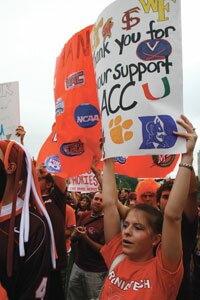
Junior Elizabeth Reeves (bottom right) lost her friend Caitlin Hammeren in the April 16 massacre.
PHOTO BY TOM DALY
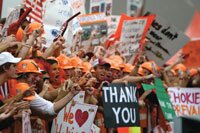
Hundreds of students showed up Saturday morning and put on their best game faces for the live broadcast of ESPN's College GameDay.
PHOTO BY TOM DALY
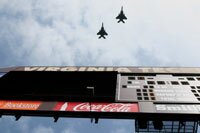
Two F-15 fighter jets from Langley Air Force Base fly over Lane Stadium at the conclusion of "The Star-Spangled Banner."
PHOTO BY TOM DALY
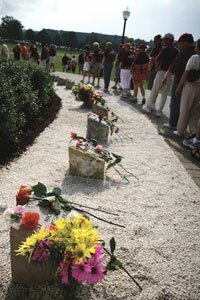
On Saturday, thousands passed through the newly-dedicated April 16 memorial.
PHOTO BY TOM DALY
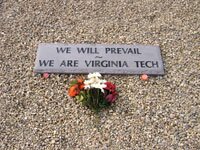
A stone bearing English professor Nikki Giovanni's famous refrain from her April 17 convocation address adorns the top of the memorial.
PHOTO BY LINDSAY BARNES
#
2 comments
Why was this story necessary? Tons of media outlets have already done stories about the healing at Tech. How much football means to us. The unity of the school. Hokie nation. Blah blah blah blah blah. I recognize that it's necessary to do stories about whether the university was at fault, how much money the families are getting, etc, but please do not come back to my school. Please don't remind me of the shootings every time I pick up the paper. Please let Hokies get to a point where we can walk around the grocery store wearing a Tech shirt and not get asked "Did you know someone who died?" Leave. us. alone.
Very lame. What's the point? You presented nothing new to me except the incident on campus 8/27. I live near the sequestered campus of WFU where armed robberies occur. Again to echo VT Alum, find some news and leave.